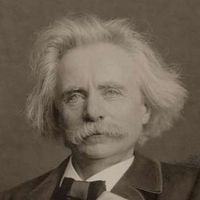Edvard Grieg (15.06.1843–04.09.1907)
Edvard Hagerup Grieg was a Norwegian pianist and composer. He studied at the Leipzig Conservatory from 1858 to 1862.

1. Biography
Edvard Hagerup Grieg was born in Bergen on June 15th, 1843. His father, Alexander, was a wealthy merchant and British consul whose ancestors had emigrated from Scotland to Norway in the 18th century – at that time still under the name Greig. From his mother, Gesine née Hagerup, the most respected piano teacher in the city, young Edvard received his first music lessons at an early age. At the age of 15, he went to Leipzig to study piano and composition at the conservatory. After completing his studies in 1862, Grieg perfected his training with the former Gewandhauskapellmeister (Gewandhaus music director) Niels W. Gade in Copenhagen. He then returned to his homeland and directed a music academy in Christiania. In 1869/70, an artist's grant enabled him to travel extensively abroad, taking him to Rome, among other places, which was a cultural hotspot for many of his compatriots at the time. In 1871, back in Christiania, he founded the “Christiania Musikforening” (Christiania Music Society) together with Johan Svendsen, the forerunner of today's Oslo Philharmonic Orchestra. From 1874 onwards, financed by the artist's salary from the Norwegian state, he lived as a freelance composer in Christiania, Bergen and Lofthus on the Hardanger Fjord, where he had established an artist's residence. From 1880 to 1882 he was director of the Bergen orchestra “Harmonien”. In 1885, he and his wife Nina moved into the “Troldhaugen” villa near the city of Bergen, which today can be visited as part of the Norwegian Edvard Grieg Museum. In the following years Grieg frequently went on concert tours, often accompanied by his wife, who was an excellent soprano. On September 4th, 1907, Edvard Grieg died in his hometown of Bergen. His urn was buried in a grotto near “Troldhaugen”. The funeral procession was joined by more than 10,000 people.
2. Private Life
Edvard Grieg had been married to the singer Nina Hagerup, a cousin on his mother's side, since 1867. Their only child, Alexandra (*1868), died when she was only 13 months old. The couple shared a passion for music. Edvard and Nina are said to have become engaged in 1864 while playing Schumann's “Spring Symphony” for piano four hands. In particular, however, Nina appeared as an interpreter of her husband's songs. Grieg is known to have considered her voice the ideal instrument for his numerous and often underestimated songs. For this reason, they often went on concert tours together.
Throughout his life, Grieg was plagued by considerable impairment of his lung function. While still a student in Leipzig, he fell seriously ill with tuberculosis, so that he had to spend half a year in his homeland for treatment. Endurance problems and breathing difficulties in the mountain heights were the result. This also explains his typically supportive gesture with the grip on his lapel, which was intended to conceal his slumped posture.
3. Connection to Leipzig
Years of Study
The fact that the Norwegian Grieg chose Leipzig as his place of study in the mid-19th century is neither an exception nor a coincidence. In 1843, Felix Mendelssohn Bartholdy founded the Conservatoire of Music here, which very quickly attracted musical talent from all over the world. Many young musicians, especially from Scandinavia, were drawn to the trade fair city. During his studies, Grieg lived as a subtenant in what is now Dresdner Strasse, just outside the city centre. With his enrolment at the conservatoire, he enjoyed the advantages of any student, including discounted concert and rehearsal tickets at the Gewandhaus. For example, Grieg experienced Clara Schumann playing her late husband's piano concerto. Grieg also attended Wagner's “Tannhäuser” up to 14 times and studied the score thoroughly. At the final examination, which took place in 1862 at the Gewandhaus, the young composer presented four of his own piano pieces, which were subsequently published as his op. 1 by the music publisher C. F. Peters. Grieg thus also managed to enter the international publishing network that was to be of decisive importance for the dissemination of his music.
Music Publisher C. F. Peters
After Grieg had initially turned his back on Leipzig after finishing his studies, contact with the music publisher C. F. Peters intensified over time. Some of the Norwegian's compositions were published here and the correspondence between the publishing director Max Abraham and Grieg became more frequent from the beginning of the 1870s. In 1875, the publishing house moved from the rooms in today's Mendelssohn House to its new domicile at Talstrasse 10, where the Grieg-Begegnungsstätte (Grieg Memorial Centre) is now located. The success of the music trade made it necessary to construct a separate building with production, distribution and storage. Abraham himself also took up residence here. The piano nobile served as the reception area. Grieg was a welcome guest. His works sold well and the publisher and composer were also close on a personal level. The initial business relationship became a lifelong friendship. Even after Abraham's nephew, Henri Hinrichsen, took over the company in 1900, the close contact continued. Every time Grieg was in Leipzig, he found accommodation in the guest room of the publishing house on the top floor. As a result, the Norwegian sometimes stayed in the trade fair city for up to several months. During one of these stays, he also arranged the first of the orchestral suites from the incidental music for “Peer Gynt”. In 1889, the prosperous collaboration between Grieg and Peters publishing house was crowned by an exclusive contract that guaranteed the composer an annual pension and, in return, the publishing house the right of first refusal on all of Grieg's works. Shortly before his death, the Norwegian travelled to Leipzig and recorded a number of his Lyric Pieces on a mechanical recording piano made by Ludwig Hupfeld.
Network
Grieg was very well connected in Leipzig and maintained numerous friendly connections with, among others, the composer Heinrich von Herzogenberg and the violinist Adolf Brodsky. The latter invited Nina and Edvard to a dinner on New Year's Day 1888, which was also attended by Johannes Brahms and Peter Tchaikovsky.
However, Grieg also used his international fame to promote up-and-coming composers. With fellow composers Johan Halvorsen, Christian Sinding and Frederick Delius, he frequently played cards, which was captured in a photograph during a social gathering on Christmas Eve 1887.
4. Reception
Throughout his life, Grieg was an esteemed composer among colleagues and extremely popular with the public. He received words of appreciation, among others, for his world-famous piano concerto composed in 1868 from Franz Liszt, who strongly supported the promotion of the then still young Norwegian. With his “Lyrische Stücke” (“Lyric Pieces”) in particular, he met the taste of the piano-loving bourgeoisie. In the 10 volumes published from 1867 to 1901, he combined the emotional expressive palette of Romanticism with the sound idiom of Norwegian folk music in an innovative way. Peters' editions of the “Lyrische Stücke” belonged to the fixed inventory of every musical household at the end of the 19th century. Even though he was criticised by some for his "Norwegian-ness", these pieces in particular made him a popular composer. The Peters publishing house always flew the Norwegian flag whenever a new work by Grieg was published. In the 1890s, he travelled all over Europe and was celebrated in the musical capitals of Paris, London and Vienna. The universities of Cambridge and Oxford awarded him honorary doctorates in 1903.
Today, the orchestral works are above all the reason for Grieg's fame, not least because of their media presence in film, television and advertising. In particular, the two Peer Gynt Suites with music from Grieg's incidental music for Henrik Ibsen's drama of the same name should be mentioned here. They include such well-known pieces as “Morning Mood”, “In the Hall of the Mountain King” and “Solveig's Song”. The Holberg Suite for string orchestra also falls into this category. The Piano Concerto in A minor is one of the most frequently performed piano concertos, along with Beethoven's, Schumann's and Tchaikovsky's contributions to the genre. And even if the “Lyric Pieces” are no longer as widespread today as they were in the 19th century, some of them still belong to the solid core of the classical piano repertoire – such as “Wedding Day at Troldhaugen” and “March of the Dwarves”. According to an analysis by the streaming service Spotify, Grieg had 2.4 million monthly listeners in December 2020, putting him in a respectable 9th place among the most-streamed classical composers, just behind Johannes Brahms but ahead of Robert Schumann, Antonín Leopold Dvořák or Peter Tchaikovsky.
5. Works
Orchestral Works and Stage Music
- 2 pieces for theatre (for Peer Gynt and Sigurd Jorsalfar)
- 2 Peer Gynt Suites with music from the pieces for theatre
- Olav Tryggvason (Opera fragment, 3 scenes orchestrated)
- Holberg Suite op. 40 (arrangement for string orchestra)
- Piano Concerto A minor op. 16
- Symphonic Dances op. 64
Chamber, Vocal and Piano Music
- String Quartet G minor op. 27
- 3 Violin Sonatas (No. 1 F major op. 8; No. 2 G major op. 13; No. 13 C minor op. 45)
- Cello Sonata A minor op. 36
- Piano Sonata E minor op. 7
- Ballade G minor op. 24
- Holberg Suite op. 40
- 10 volumes of “Lyric Pieces” (opp. 12, 38, 43, 47, 54, 57, 62, 65, 68, 71)
- Numerous small-scale piano pieces, including several adaptations of folk songs
- Some works for piano four hands
- approx. 180 songs for piano
- Songs for male-voice and mixed-voice choir
Audio Samples
Shortly before his death, the Norwegian travelled to Leipzig and recorded a number of “Lyric Pieces” on a mechanical recording piano made by Ludwig Hupfeld: https://www.youtube.com/watch?v=uIsb9YitbI0
Norwegian Dances https://www.youtube.com/watch?v=Geh_JOVR8ak
Holberg Suite https://www.youtube.com/watch?v=j1wQ8ZMZq60
Grieg plays "Wedding Day at Troldhaugen" (1906) https://www.youtube.com/watch?v=uIsb9YitbI0
6. Sources and Links
Printed
Benestad, Finn and Schjelderup-Ebbe, Dag: Edvard Grieg. Mensch und Künstler, Leipzig 1993
Brock, Hella and Benestad, Finn (ed.): Edvard Grieg. Briefwechsel mit dem Musikverlag Peters, Frankfurt 1997
Brock, Hella: Edvard Grieg, Mainz 1998
Dinslage, Patrick: Edvard Grieg und seine Zeit, Laaber 2018
Reisaus, Joachim: Edvard Grieg und das Leipziger Konservatorium, Leipzig 2002
Online
https://en.edvard-grieg.de/edvard-grieg
https://www.edition-peters.de/griegverleger (German only)
https://en.wikipedia.org/wiki/Edvard_Grieg
Image
de.wikipedia.org/wiki/Edvard_Grieg




